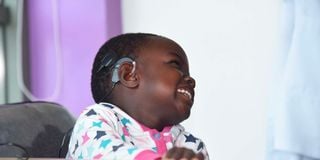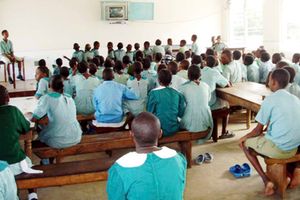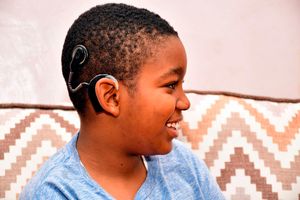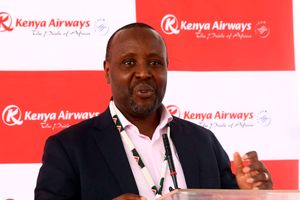Heart-warming moment: Baby born deaf starts to hear

Baby Jemimah Kimutai with a speech processor attached to a cochlear implant at the Nairobi Audiology Center on September 20, 2023.
What you need to know:
- After surviving a preterm birth and losing a mother to cancer and a twin brother days after their birth, Jemimah remained a beacon of hope to her family. It was only two years after she was born beacon that her family discovered she could not hear.
- Last month, she underwent a cochlear implant surgery, one that is making her explore a new world filled with sound.
Irene Kimari opens the door of an audiology consultation room and two people walk in for their appointment.The first to enter the room is little Jemimah Kimutai, 4, followed by her uncle, Bernard Kimutai, a devoted chaperone for the day’s clinic visit.
The Healthy Nation team is at the clinic to witness Jemimah’s reaction to hearing sounds for the first time.
She was born four years ago, and it was only last year that her dad, Gilbert Kimutai, discovered that her lastborn daughter had profound deafness.
For more than a month, the Healthy Nation team waited for this day, clinically known as –the Switch -On, which is done four weeks after one undergoes a cochlear implant surgery.
Bernard watches her niece closely as she takes a seat close to him. She removes a head band from her head and chuckles at Irene, the clinical audiologist who is working closely with Dr Serah Ndegwa, a consultant audiologist at the Hearing Implants Centre in Nairobi.
All the attention
Dr Ndegwa explains to the family what to expect during this switch-on session. She then connects a Sonnet two speech processor to the computer through an interface known as a max box. All the attention in the room then turns to Jemimah as Irene places the speech processor onto her right ear.
Dr Ndegwa opens Jemima’s file on the computer and begins the switch-on process.

A speech processor is attached to a cochlear implant on Jemimah Kimutai's ear at Nairobi Audiology Center on September 20,2023 as Irene Kimari , a clinical audologist, looks on.
Bernard is staring at her niece, we all are. The speech processor affixed by Irene is about to do its magic. Irene stands behind Jemimah, who is now finger-flicking and unbothered by what is happening around her. We are mostly talking about the reaction she is likely to make after the switch-on. As our speculations fly, little Jemimah is engrossed in her game using her fingers.
Dr Ndegwa checks to ensure that the readings on the computer are okay –she calls it a mapping session – and a range of lines and graphs of recordings known as telemetry and Ecap show up on the screen’s monitor, with details that only an audiologist can understand. She explains that these are neural response measurements which are used to program the speech processor to produce a sound stimulus that is loud enough to be heard and comfortable.
“Are you ready Irene? She asks her colleague. I’m about to activate the speech processor now.”
“Yes,” Irene responds, now looking at Jemimah who is still engrossed in her game using her fingers.
“Okay, she is now live, go ahead and clap your hands softly behind her,” she tells Irene.

Dr Serah Ndegwa, a consultant audiologist, guides Jemimah using sign language.
One, two, three, four, five, six claps later, Baby Jemimah turns around with a look of surprise at hearing sound for the first time. Her face lights up with a radiant smile as she looks at Irene, showing off her beautiful set of teeth.
Her contagious smile is irresistible, we all cave in, and gleefully smile back at the magic of seeing her respond to sound.
“Today marks day one of her hearing journey,” Dr Ndegwa remarks
Irene claps again, and the reaction is the same. She takes another tool, a rattle, one which makes the sound of a kayamba, and as she shakes it, Jemimah excitedly turns to this sound as well.
Jemimah seems fascinated by this sound. She takes the toy from Irene’s hands and shakes it, seeming surprised at the realisation that the rattle makes a sound when shaken.
She keeps smiling, the uncle is looking at hope firsthand, and we are all spellbound.
Just last month, the baby was wheeled to a theatre room at Nairobi Hospital for a surgery that will now change her life forever. Beneath her right ear is a cochlear implant, which is linked to the speech processor through a coil magnet, that will enable her to hear throughout her lifetime. The surgery was conducted by a team of ENT doctors from the Cochlear Implant Group of Kenya (CIGOK) who specialise in cochlear implantation, led by Prof Isaac Macharia and world renowned ENT surgeon, Prof Mario Sanna, from Italy.
When Jemimah was born four years ago, her mother had two options –to either live or give a chance to her twins to live. She had been diagnosed with breast cancer two years before Jemimah and her late twin brother were born.
Gilbert tells Healthy Nation that his wife’s situation deteriorated when their twins were only 31 weeks. That is when doctors presented the two grim choices.
His wife chose to give the twins a chance at life and underwent an emergency caesarean section. On May 9, 2019, two beautiful babies were born at a hospital in Eldoret. They were born pre-term and had low birth weight at the time. Jemimah weighed 1.2 kilogrammes. Her brother did not survive, he died two days later.
“The news of my son’s death broke my wife’s heart. Two weeks later, she also died and I was left to care for Jemimah,” says Gilbert.
Jemimah stayed at the newborn unit for about two months and she was closely monitored by her father and paternal grandmother.When she was finally discharged, the family knew that everything was okay.
“She could play like a normal child does. She made sounds like a child. We did not at any point think that she had any complications. However, at the back of my mind, I knew that the doctors had once told me that the chemicals from her mother’s cancer treatment may affect the children,” Gilbert tells Healthy Nation.
“I celebrated every milestone she made; from opening the eyes to sitting, standing, walking…it’s only speech that was taking longer than usual as she was already two years old but still couldn’t talk,” he says.
The first hospital he went to, he was told that his baby just had delayed milestones and that she would catch up with time. That was in 2020.
“I became alarmed in 2021 when my mother told me that my child seemed to have a hearing problem. I took her to an ENT surgeon who said that she had enlarged adenoids and advised that she undergoes surgery,” he narrates.
That did not work. He went to yet another doctor who offered his child hearing aids, but that too did not resolve the problem.
He was also told to go to a speech therapist but Gilbert was curious to know if indeed his child could hear anything at the very least.The speech therapist told him to monitor the situation and advised him of a new option in the country that would help her daughter –a cochlear implant surgery.
First, they had to have a hearing test to ascertain that their child was indeed deaf. They did the test and his worst fear was confirmed –Jemimah was deaf.
“It broke my heart,” he says.
That is when he started the cochlear implant surgery process and had to travel to Nairobi to get this service. “I always imagined that my child could hear one day. I believed she could after the first surgery when her adenoids were removed, but she did not. The hearing aids too did not work, my last resort was the cochlear implant,” he tells Healthy Nation.
At some point, Gilbert had resigned to fate and he took Jemimah to a special school.
“I felt like there was no hope yet I am a believer. I went for prayers and knew something would work out. At this time, my child had undergone all the required tests and we were looking for money to facilitate the cochlear implantation,” he says.
His prayers were answered. A specialist ENT surgeon from Italy, Prof Sanna, coincidentally visited Kenya at a time when Jemimah really needed the surgery. Through his foundation, the Mario Sanna Foundation in collaboration with MED-EL and Hearing Implants Limited, he donated cochlear implants to eight Kenyan children. Jemimah was one of the lucky beneficiaries.
Four weeks after the surgery, the Healthy Nation team is at the clinic and Gilbert’s wish for his child to hear again is finally coming to pass. Bernard, the uncle, says this process has brought so much joy to the family.
“Jemimah is doing well, we as a family are committed to making sure that she attends regular speech therapy sessions and audiology appointments as required. We know that it is a gradual process, but we are determined to put in the work required until she develops speech,” he says.
“We will now enrol her in a regular school where she can interact with children with normal hearing as she can now hear.”
Jemimah would have received her cochlear implant at a much younger age but she lost time due to the delayed diagnosis. Dr Ndegwa informs us that performing cochlear implantation for children with profound deafness at the youngest age possible, preferably below two years of age, gives them the best chance to acquire speech, language and communication skills that approximate to that of their peers with normal hearing.
What happens in other parts of the world? You may ask.
Dr Ndegwa explains that in developed countries, the standard practice is a universal newborn hearing screening where every newborn baby has a hearing screening test done before discharge from hospital.
“Newborn hearing screening can be conducted within hours of a child’s birth through a quick test known as otoacoustic emissions. The babies who do not pass this test are referred for diagnostic hearing tests and if a hearing loss is confirmed, early intervention is done,” she adds.
Besides maternity units, immunisation and well-baby clinics also provide a good platform for infants to get their hearing screening done.
“The Joint Committee On Infant Hearing recommends the 1-3-6 Principle, which states that hearing screening should be done within one month of a child’s birth, diagnosis of hearing loss made by the third month and intervention for the hearing loss by month 6,” she explains.
Dr Ndegwa explains that hearing loss is often referred to as a hidden disability and has been rated as the fourth leading cause of disability in Kenya. She adds that the impact of hearing loss on a child includes delayed speech and language development, communication difficulties, poor academic achievement, social isolation, loneliness and stigma.
Causes of hearing loss
Dr Ndegwa explains that the common causes of conductive hearing loss include wax impaction, ear infections such as chronic otitis media, otitis media with effusion (fluid in the middle ear) and a perforated eardrum.
On the other hand, the causes of sensorineural type of hearing loss in children includes genetic causes, prematurity, low birth weight of below 1,500 grams, severe jaundice, ototoxic medication, neonatal sepsis, family history of deafness, consanguinity, in-utero infections such as rubella, cytomegalovirus, herpes and others. She advises that children with these risk factors of hearing loss should have their hearing tested.
The causes of sensorineural type of hearing loss in adults include ear infections, exposure to loud noise levels, ototoxic medication, meningitis, age-related and other diseases such as diabetes and hypertension.
The management of hearing loss can be through medical, surgical or rehabilitative interventions such as hearing aids and cochlear implants.
However, not everyone is eligible for cochlear implants — it is only ideal for people with a severe to profound degree of hearing loss and those who have minimal benefit from use of hearing aids.
As for Jemimah, she will now be able to hear the sounds around her, hear her own voice, the voices of her family members and gradually over time develop speech and language like her peers. Now that she can hear, she will be able to join mainstream school and achieve her full potential.
What is a Cochlear implant?
It is an electronic device that is surgically implanted into the inner ear (cochlea) to provide direct stimulation to the hearing nerve. It comprises of an internal component, which is the implant, and an external component known as a speech processor. The speech processor collects sounds and converts them into a digital signal that is transmitted to the internally implanted electrode array, which in turn stimulates the hearing nerve leading to sound perception. Dr Ndegwa explains that preparation for cochlear implantation requires a multi-disciplinary team approach to conduct a medical, audiological, speech and language and psychological evaluation of the potential cochlear implant recipient.
A high resolution computed tomography scan and a magnetic resonance imaging are routinely performed before the surgery to evaluate the anatomy of the inner ear and the structure of the hearing nerve.
“Audiological follow-up is the other essential part of the post implantation rehabilitation process and it involves mapping (programming) of the speech processor to optimise hearing. Speech and language therapy is a critical part of the rehabilitation process following cochlear implantation. The goal of this is to help children to acquire speech and language and enable them to attend mainstream school,” she explains.
About a month after the implantation is done, the cochlear implant recipient like Jemimah comes for the initial activation of the implant, otherwise known as switch-on. “This is when the cochlear implant recipient gets to hear sound. It is a very exciting moment for the family to see their child respond to sound for the very first time,” says Dr Ndegwa.
“The initial programme allows the child to have sound awareness with optimal hearing being achieved gradually over several weeks after the initial switch-on. During this period the child is required to attend weekly speech and language therapy sessions.”
Adults who have post lingual profound deafness can benefit from cochlear implantation by regaining speech perception and an improvement in their quality of life. While this type of surgery is fairly old in other parts of the world, it has started to gain momentum in Kenya recently. In June this year for instance, the Moi Teaching and Referral Hospital in Eldoret became the first public institution to perform a cochlear implant surgery in East Africa.
Prior to that, a private hospital in the country had performed a similar surgery to six patients courtesy of a partnership.
A study published in the scientific journal JAMA Network shows that as a child begins to respond to auditory input, they will generally have better life outcomes.
“His or her ability to regulate attention and behaviour will likely increase.”
Seven stages of listening after a switch-on
Detection –noticing everyday sounds after the switch-on of the cochlear implant
Discrimination -telling two sounds such as car tooting versus a doorbell ringing
Identification –selecting what you have heard from a choice
Recognition –repeating what you have heard
Comprehension –listening and understanding what you hear
Conversation –being able to follow and take part in conversations
Telephone conversation –being able to have phone calls with people you know, and those you don’t
Source: Oxford University Hospitals





